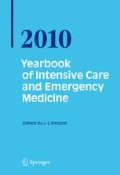Abstract
Direct arterial blood pressure monitoring is frequently undertaken in operating rooms, critical care units, emergency departments and coronary care units where rapid alterations in hemodynamic status may occur in response to the underlying disease and/or treatment. In addition to providing a beat-to beat measurement of blood pressure, a careful study of the individual components of the arterial pressure waveform will also enable a more comprehensive assessment of several other hemodynamic parameters that may influence treatment [1–4]. Changes in circulating volume (or ventricular preload), stroke volume (an important determinant of cardiac output), volume responsiveness and peripheral vascular resistance (or afterload) are some of the more important variables that may be inferred from the arterial pressure trace. Understanding the significance of all the components of an arterial pressure waveform is, therefore, an essential skill for hospital doctors involved in the care of acutely ill patients. In this case-based discussion we will present a series of arterial pressure recordings that illustrate some of the clinically important concepts.
Access this chapter
Tax calculation will be finalised at checkout
Purchases are for personal use only
Preview
Unable to display preview. Download preview PDF.
References
Pinsky MR (2003) Probing the limits of arterial pulse contour analysis to predict preload responsiveness. Anesth Analg 96: 1245–1247
Marquez J, McCurry K, Severyn DA, Pinsky MR (2008) Ability of pulse power, esophageal Doppler, and arterial pulse pressure to estimate rapid changes in stroke volume in humans. Crit Care Med 36: 3001–3007
Michard F, Chemla D, Richard C, et al (1999) Clinical use of respiratory changes in arterial pulse pressure to monitor the hemodynamic effects of PEEP. Am J Respir Crit Care Med 159: 935–939
Michard F, Boussat S, Chemla D, et al (2000) Relation between respiratory changes in arterial pulse pressure and fluid responsiveness in septic patients with acute circulatory failure. Am J Respir Crit Care Med 162: 134–138
Dark P, Little R, Nirmalan M, Purdy J (2006) Systemic arterial pressure wave reflections during acute hemorrhage. Crit Care Med 34: 1497–1505
Author information
Authors and Affiliations
Editor information
Editors and Affiliations
Rights and permissions
Copyright information
© 2010 Springer-Verlag Berlin Heidelberg
About this chapter
Cite this chapter
Nirmalan, M., Pinsky, M.R. (2010). Direct Arterial Pressure Monitoring: Pattern Recognition in the Management of Circulatory Failure. In: Vincent, JL. (eds) Yearbook of Intensive Care and Emergency Medicine 2010. Yearbook of Intensive Care and Emergency Medicine, vol 2010. Springer, Berlin, Heidelberg. https://doi.org/10.1007/978-3-642-10286-8_6
Download citation
DOI: https://doi.org/10.1007/978-3-642-10286-8_6
Publisher Name: Springer, Berlin, Heidelberg
Print ISBN: 978-3-642-10285-1
Online ISBN: 978-3-642-10286-8
eBook Packages: MedicineMedicine (R0)

